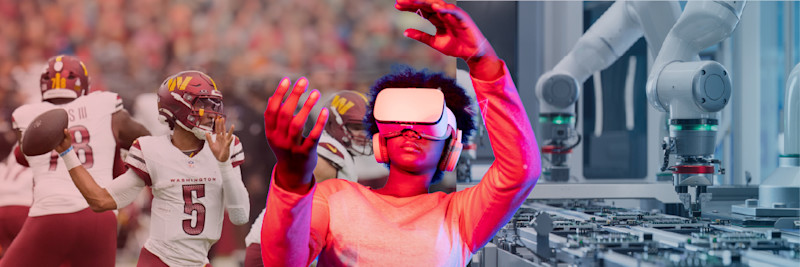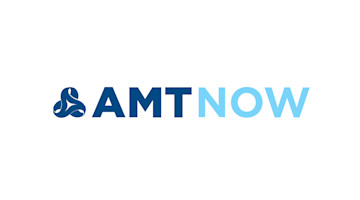Based in the Washington, D.C., metropolitan area, AMT – The Association For Manufacturing Technology has witnessed presidential administrations, royal dignitaries, awful traffic, and – perhaps most ever-present over the last quarter-century – bad football. That all changed in 2022, when the then-owner of the Washington Commanders, Daniel Snyder, under mounting scandals and pressure from the NFL, sold the team to a group helmed by Philadelphia 76ers owner Josh Harris.
Under newly hired general manager Adam Peters and head coach Dan Quinn, the Commanders selected quarterback Jayden Daniels second overall in the 2024 NFL draft. The winner of the 2023 Heisman trophy, Daniels was immediately tasked with turning around the team’s fortunes.
The result? Led by Daniels’ poise and incredible playmaking abilities, the Commanders rose from irrelevancy and a 4-13 season in 2023 to a 2024 season filled with must-see games that ranged from miraculous and jaw-dropping to painfully frustrating – and an improbable run deep into the playoffs worthy of any fairytale. While the results were unexpected (at least this soon in his development), the secret to Daniels’ rookie success has been clear from the start: virtual reality.
More Real Than Real
German VR software developer Cognilize was founded in 2019 by business partners Verena Krakau and Christian Hartmann. The duo extensively researched neurobiology, decision-making, and biomechanics to feed their VR simulator, which was originally intended for soccer players. In 2021, Cognilize began incorporating American football into its programming, and in March 2023, they met with the football department at Louisiana State University. Impressed, LSU partnered with Cognilize to build out the programming, feeding it plays and real-world football data.
More important than the realism of VR training is perhaps its ability to manipulate that realism. Daniels sets the training speed to 1.75 – nearly 80% faster than what he’d experience in a real game. Then, at gametime, everything slows down for him. That September, he strapped on the headset for the first time in the week leading up to LSU’s game against Mississippi State. He went on to throw for 361 yards, rush for 64 more, and account for four total touchdowns in a lopsided 41-14 win. Since then, VR training has been an integral part of his practice and was a key purchase for the Washington Commanders after Daniels was drafted.
With VR’s faster speed, Daniels’ processing naturally sped up, and his development accelerated. The Commanders’ staff and players noticed the benefits right away, particularly for other quarterbacks. In an October article for The New York Times, backup quarterback Sam Hartman said, “Reps are always few and far between for everybody, especially at the level and pace we’re going. The goal for quarterbacks is getting reps and seeing every play a million times. (VR) really helps.”
So, the attention and resources to gain specialized expertise becomes more accessible to a larger swath of workers. If it can work for a quarterback, it can work for manufacturing – and there’s more than ample evidence of it working.
The 2022 paper “An experimental study of the impact of virtual reality training on manufacturing operators on industrial robotic tasks” compared two groups of students training to use a robot in drawing and pick-and-place operations. One group was trained on a VR robot, while the second group was trained on a physical robot. Then they switched training techniques. The results showed that “students that used VR first were quicker to complete the tasks … and at a higher pass rate” than those who used the physical robot training before VR. Notably, “75% of participants think – after being involved in the experience – that the virtual training program would be an easier and more effective way of training novice operators, compared to using a physical robot.”
Faster. More effective. More accurate. Not a bad way to begin your new workers’ (or players’) careers.
Safety (Not the 2-Point Kind)
In the NFL, injuries are part and parcel with the job – even in practice. Between 2015 and 2024, the NFL reported 399 instances of concussions during practice. VR programs, like Cognilize, which was originally designed for soccer players to gain mental reps without the accompanying wear and tear on their bodies or needing a full team around them, provides workers and players alike an important feature in their training: safety and wellness.
As more manufacturers turn to robotics and automation to maintain their company’s competitive edge and meet workforce needs, the importance of worker safety will naturally grow. The 2022 robot training comparison noted that users were originally hesitant but were reassured that “with the virtual training, a trainee would … be aware of potentially causing damage, thanks to the collision detector.” Through VR training, workers learn faster and more safely.
Virtual Reality Makes ‘Cents’
Gaudy numbers attached to dollar signs are no stranger to professional sports. In the NFL, a quarterback regularly commands the lion’s share of a team’s salary cap: Quarterback Joe Burrow’s 2024 salary took up 24.5% of the Cincinnati Bengals’ cap space. The Bengals, notably, missed the playoffs. Daniels’ 2024 rookie salary, determined by the NFL’s collective bargaining agreement, accounted for a mere 2.6% of the team’s cap. His ability to produce at a high level while on his rookie deal is a virtual embarrassment of riches. The Commanders, with the third-most cap space going into the 2025 season, will have plenty of capital to build around Daniels.
Manufacturing works the same. The faster and cheaper a worker is fully trained, the faster the company can produce, leaving more resources available to improve efficiency and safety, purchase equipment, allocate toward R&D, increase its workforce, and compensate competitively. Lincoln Electric, a maker of arc welding products, offers a VR training program to educators which reduces the time to fully train welders – and drastically saves on materials. Lincoln Electric quoted Craig Triplett of the Chicago Regional Council of Carpenters Training Center as saying the program saved the organization “tens of thousands of pounds of material, not to mention electricity for all of the equipment, which is tremendous.”
Virtual reality also opens new pathways for growth and partnership possibilities. At IMTS 2024, Siemens CEO Barbara Humpton discussed the development of the industrial metaverse in collaboration with Nvidia, which connects the Siemens Xcelerator and Nvidia Omniverse platforms. By leveraging Siemens’ digital models, Nvidia’s AI, and digital twin technology, this VR workspace forms the foundation of BMW’s electric vehicle production plant, reducing errors, speeding up innovation, and lowering costs – all without the need for in-person interaction.
Virtual Reality’s Star Power
With a widening skills gap and persistent workforce shortages, the manufacturing industry is turning to automation and other advanced technologies for solutions to meet demand. But who will control these machines?
Influencers like Andrew Crowe, leader of The New American Manufacturing Renaissance, and Mavens of Manufacturing CEO Meaghan Ziemba work tirelessly to attract a new, diverse generation of workers to an industry eager for their inclusion. Between the two of them, Crowe and Ziemba held more than a dozen sessions at IMTS 2024, many of which focused on developing manufacturing recruitment strategies. Sessions like Crowe’s “From the Streets to the C-Suites: Unlocking Manufacturing’s Hidden Talent Pipeline” urged manufacturers to find young talent by developing a presence on digital venues like TikTok. In Ziemba’s “Championing the Cause of the Next Generation,” attendees learned how manufacturer Zoller uses their internship program to attract younger workers.
Normalizing digital technologies and placing them in a context that’s accessible to younger audiences is key to connecting with young talent. The use of VR training by a charismatic young NFL superstar like Daniels would certainly help spread awareness about the technology’s benefits. Suddenly, it’s more than the latest gadget. It’s cool.
And Daniels’ superstardom isn’t just anecdotal. For the 2024 NFL season, his was the top-selling jersey – across every sport in the entire sports world. Commanders merchandise sales leapt 463% compared to 2023 and skyrocketed 4,129% once they made the playoffs. On Nickelodeon’s children-focused “NFL Slimetime” show, which recaps each NFL week, Daniels received the Nickelodeon Valuable Player award – twice. With only the Super Bowl remaining, only one other player this season has received the award more than once. Manufacturing, long burdened with an outdated reputation for being dirty and dangerous, would do well to leverage this attention.
After all, like Daniels, VR is a showstopper. At IMTS 2024, more than a dozen booths, including Siemens and Microsoft, showcased VR and VR-adjacent technology. Such exhibitions included Visometry’s augmented reality-enhanced visual quality inspection solutions; iQ3Connect’s extended reality platform for industrial enterprises to train and collaborate at scale; and the Smartforce Student Summit, where 14,713 students interacted with breakthrough technologies like VR.
Perennially cool carmaker Porsche uses augmented reality in product demonstrations, where journalists are invited to explore their vehicles from unique perspectives previously unattainable, and specialized repair work, connecting engineers to mechanics from opposite ends of the world. Manufacturing software company and IMTS 2024 exhibitor PTC agrees, noting on their website that the “clarity of AR instructions prevents errors” and AR solutions “enable experts to be available anywhere they’re needed, cutting travel costs.” This is underscored in the 2022 robot training comparison, which found that 75% of the students thought VR training provided an “easier and more effective way of transferring knowledge and experience, as opposed to training with conventional methods.”
More Than Rebuilding
With Daniels’ rookie year now in the books and his AP NFL Rookie of the Year Award all but guaranteed, examples of the NFL being a “copycat league” will surely soon appear. Daniels now holds several records, including the most NFL Rookie of the Week awards ever, most offensive yards by a rookie, and the most touchdown passes in the final 30 seconds of regulation or overtime – meaning he has led more comeback wins in the final moments of a game than any rookie or veteran quarterback in one season – ever. With numbers like these, it won’t be long before more colleges and NFL teams implement VR training in search of similar results.
More to the point: Will manufacturers who don’t use VR training be able to compete with those who do?
For young people, VR will be commonplace. In fact, Prescient & Strategic Intelligence projects that the metaverse market, which incorporates VR, will generate over $1.5 trillion in revenue by 2030. Grand View Research predicts VR gaming will grow at a CAGR of 21.6% from 2025 to 2030 from an estimated $32.4 billion valuation in 2024. While headsets like the Apple Vision Pro may be a commercial failure, specific use cases for VR like gaming, training, and social media are on the rise. Aligning the identity of manufacturing with such technologies would go a long way to attracting younger people’s attention. It’s worth it. After all, virtual and mixed reality initiatives offer manufacturers solutions to get the most out of their people quickly – even on the world’s biggest sports stage.
To learn more about virtual reality training and education, visit the Smartforce Student Summit, the list of IMTS exhibitors who use VR, or the AMT member directory.






